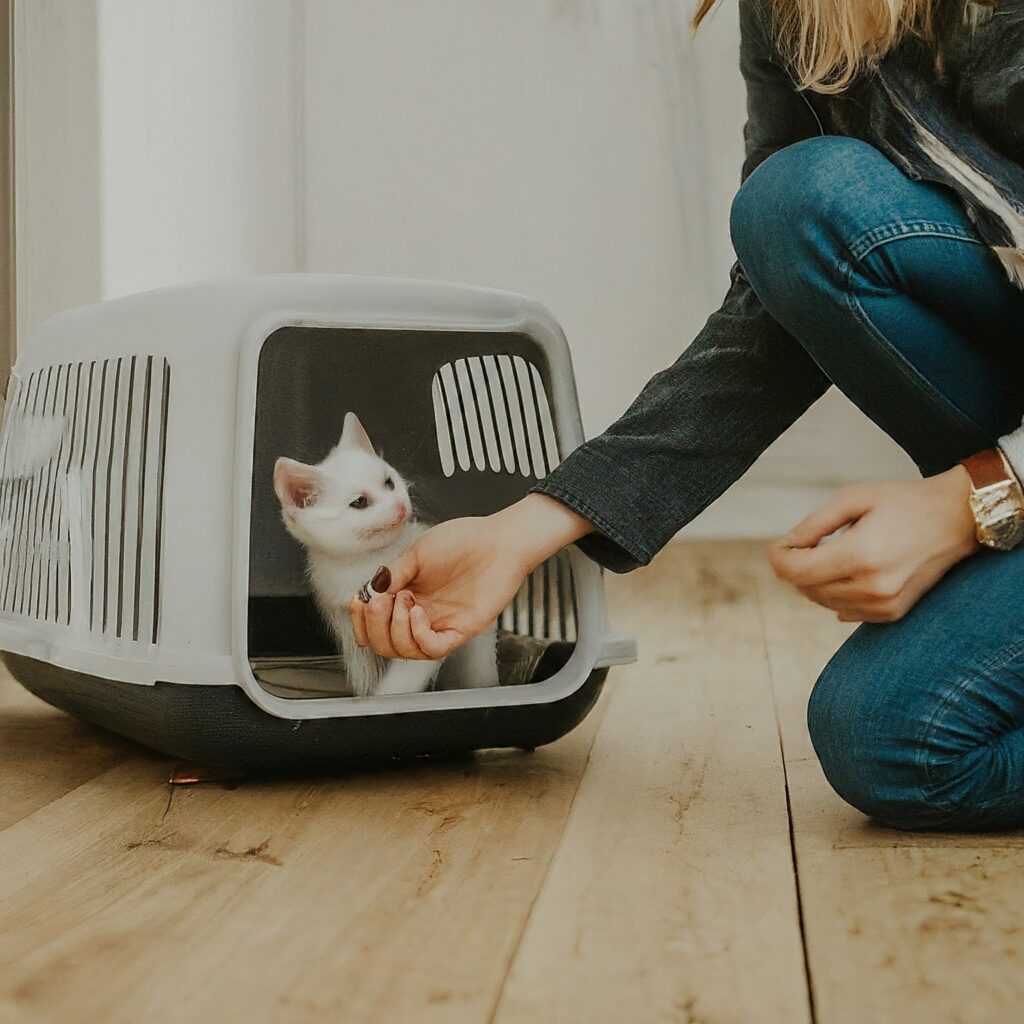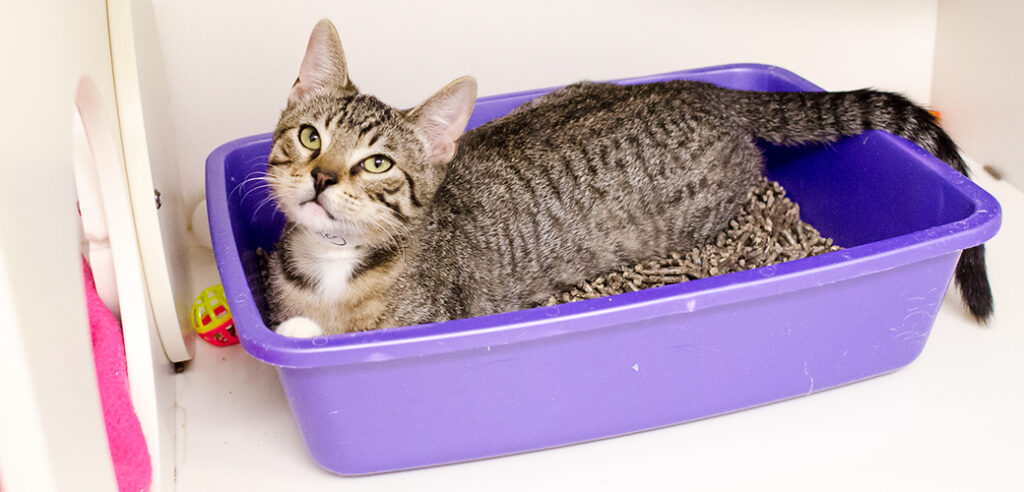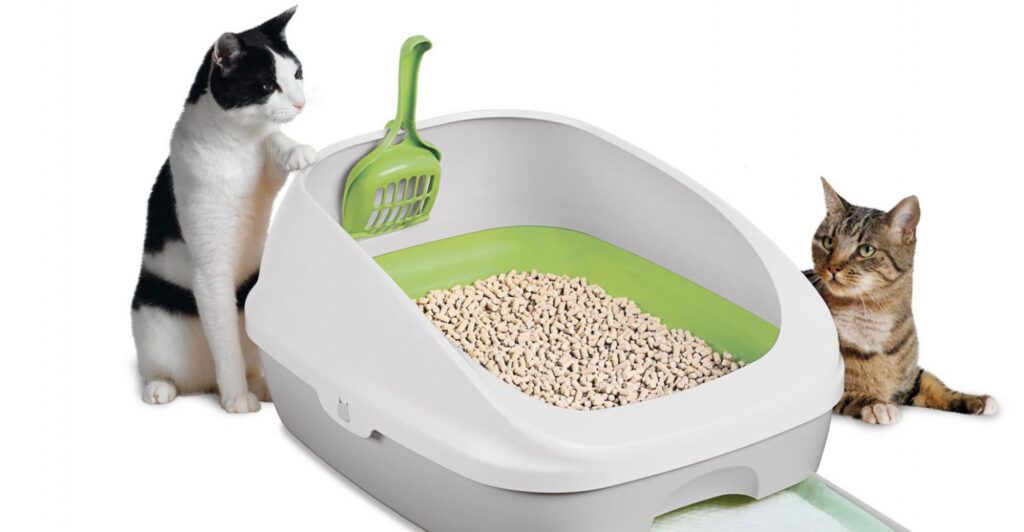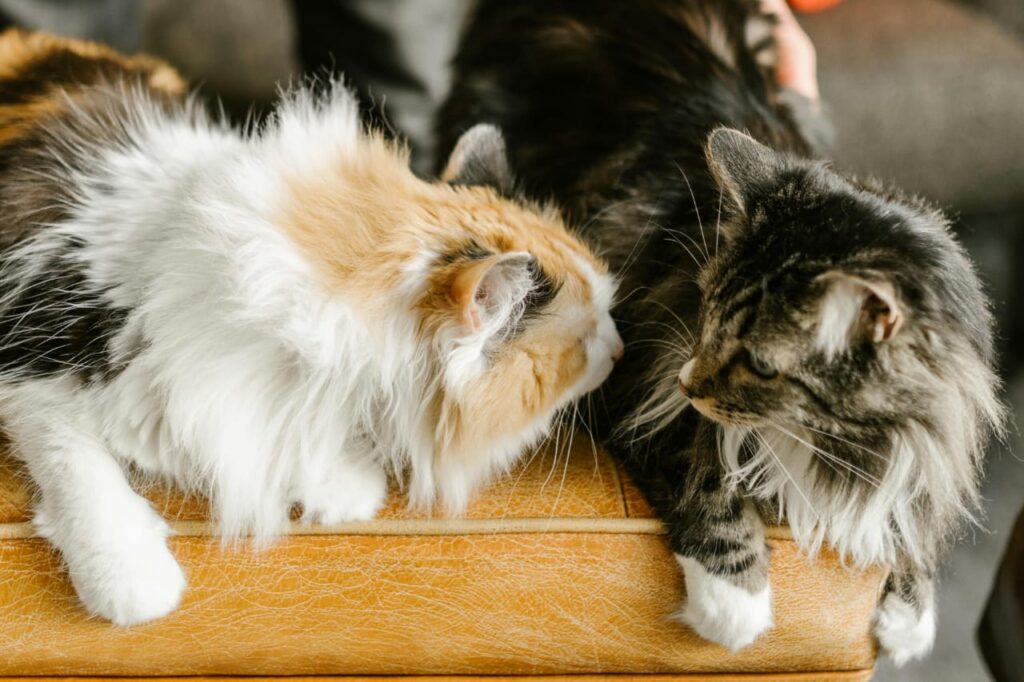
Cats are known for their independent nature and unique behaviors, but when they start urinating inconsistently, your concerns about
Why does your cat start urinating outside the litter box? Cats are known for their cleanliness and unique behavior, so when they start
Peeing outside the litter box raises concerns for cat owners. This comprehensive guide will explore the various reasons behind this behavior and provide effective solutions to help you clear out your concerns and your cat’s problems that may cause it to do this.
Let’s explore the issues with cats urinating outside of the cat litter box and find a solution to this problem.
Table of Contents
- 1. Understand why your Cat pees outside the Litter Box?
- 2. Medical Causes: Cat Inappropriate Urination Issues:
- 3. Behavior that causes the cat to pee outside the litter box
- 4. Environmental & Litter Box Setup Problems
- 5. Litter Box Issues: Inconsistent Litter Box Usage
- 6. Solutions and Prevention for Cat Peeing Outside the Litter Box
- 7. How to Discipline a Cat for Peeing Outside the Litter Box
- 8. Special Situations: When Peeing Outside the Litter Box Gets Tricky
- 9. Quick Summary Checklist for the Entire Guide
- Conclusion:
- FAQs:
1. Understand why your Cat pees outside the Litter Box?
If you’re wondering, “Why is my cat peeing outside the litter box?”, you’re not alone. According to veterinary studies, at least 10% of cats will experience litter box issues at some point in their lives. It’s one of the most common behavioral problems cat owners face—and there’s always a reason behind it.
Sometimes, your cat simply can’t help it. Conditions like urinary tract infections (UTIs), bladder stones, diabetes, or kidney disease can make urination painful or urgent. If your cat associates that pain with the litter box, they might start avoiding it altogether.
Cats are sensitive creatures. A new pet, a change in routine, or even loud noises can stress them out. Stress often triggers inappropriate urination as a coping mechanism. Some cats also spray to mark territory, especially in multi-cat households.
Believe it or not, the litter box itself might be the problem. If it’s dirty, in a noisy area, too small, or you’re using a litter your cat dislikes, they might choose your carpet instead. Multi-cat homes with too few litter boxes can also lead to accidents.
The key takeaway? Your cat is trying to communicate with you. Peeing outside the litter box isn’t revenge—it’s a signal something’s wrong. Identifying whether it’s medical, behavioral, or environmental is the first step to fixing it.
2. Medical Causes: Cat Inappropriate Urination Issues:
One of the first considerations when a cat starts urinating outside the litter box is the possibility of underlying medical issues. Conditions such as urinary tract infections, bladder stones, or kidney disease in cats can cause discomfort and lead to inappropriate elimination behavior. Consulting with a veterinarian is crucial to rule out any medical concerns and ensure your cat’s health and well-being.
Urinary Tract Infections
Urinary tract infections (UTIs) are a prevalent cause of inappropriate urination in cats. These infections can cause discomfort and pain during urination, making it uncomfortable for your cat and leading them to avoid the litter box. It’s essential to recognize the signs of a UTI and seek prompt veterinary care to eliminate your cat’s discomfort.
Kidney Problems and Diabetes
Issues with the cat’s kidneys can also lead to changes in urination patterns. Cats may exhibit increased thirst, frequent urination, or accidents outside the litter box. If you notice any kidney problems, consult your veterinarian for proper diagnosis and management.
FLUTD (Feline Lower Urinary Tract Disease)
FLUTD is a group of conditions that cause inflammation and urinary blockages. Male cats are especially at risk for life-threatening blockages. Signs include frequent squatting with little urine output and excessive licking of the genital area.
What to do: FLUTD is an emergency. If your cat is straining and producing little to no urine, go to the vet right away.
Bladder Stones
Bladder stones can block urine flow and cause extreme discomfort. Cats with stones often urinate in small amounts or outside the box because it’s painful to go normally.
What to do: Treatment may involve a special diet or surgery, depending on the severity.
Diabetes
Cats with diabetes drink and urinate more than usual. If the litter box isn’t cleaned frequently, they may choose other spots instead.
What to do: A blood test can confirm diabetes. Managing diet and insulin (if needed) can control symptoms.
Kidney Disease
Kidney problems make cats urinate more often. If your cat can’t reach the litter box in time, accidents happen.
What to do: A vet check-up with bloodwork is essential for diagnosis and treatment options.
Arthritis in Elderly Cats
Older cats may struggle to climb into high-sided litter boxes. Pain in the joints makes using the box difficult, leading them to pee on soft, accessible surfaces like carpets.
What to do: Use low-entry litter boxes and place them in easy-to-reach locations.
Important: If your cat suddenly starts peeing outside the litter box, don’t assume it’s behavioral. Always rule out medical problems first with a veterinary check-up. Untreated urinary issues can become life-threatening.
📌 Read more from Cornell University College of Veterinary Medicine about urinary tract diseases in cats.
3. Behavior that causes the cat to pee outside the litter box
If your vet has ruled out medical problems, the next most common reason for a cat peeing outside the litter box is behavioral issues or stress. Cats are sensitive animals, and even small changes in their environment can throw them off balance. Let’s break down the key triggers:
Stress and Anxiety Triggers
Cats are sensitive creatures that can be easily affected by changes in their environment. Events such as moving to a new home, the introduction of a new pet, or disruptions in their routine can trigger stress and anxiety, leading to litter box aversion. Creating a calm and stable environment for your cat, along with providing plenty of enrichment and hiding spots, can help alleviate stress and prevent accidents.
Territorial Marking
Territorial marking is a natural behavior in cats, especially in neutered males and sometimes spayed females. This behavior involves spraying urine in specific areas to establish territory. Neutering your cat can help reduce territorial marking behavior, but environmental enrichment and behavioral modification techniques may also be necessary.
If you like odorless cat litter that best fits into your cat litter box, then you should go for Tofu cat litter. Here is our full guide on Tofu cat litter
Attention-Seeking Behavior
Some cats pee outside the box to get your attention, especially if they feel neglected. This can happen if you’ve been away more than usual or are busy at work.
What to do:
- Schedule daily interactive play sessions.
- Avoid punishing your cat; instead, reward them for using the litter box.
New Additions to the Home
A new pet, baby, or even a guest can make your cat feel insecure. In their mind, peeing in visible spots is a way to reclaim territory.
What to do:
- Introduce new pets gradually.
- Keep your cat’s essentials (food, water, litter) in a stress-free location.
Pro Tip: Never punish your cat for peeing outside the litter box—it will only increase anxiety and make the problem worse. Instead, identify the stressor and create a calm, predictable environment.
4. Environmental & Litter Box Setup Problems
Sometimes, the reason your cat is peeing outside the litter box has nothing to do with health or stress—it’s the litter box setup itself. Cats are picky creatures, and if their bathroom isn’t up to their standards, they’ll find a new one (like your carpet!). Here are the most common environmental issues:
Dirty Litter Box
Cats are clean animals. If the litter box smells bad or is full of clumps, they’ll avoid it. Imagine using a dirty bathroom—you wouldn’t like it either!
What to do:
- Scoop the litter box at least once a day.
- Wash the box with mild soap and water weekly.
- Replace litter completely every 1–2 weeks.
Wrong Litter Type
Not all cats like the same texture or smell. Strongly scented litter can irritate sensitive noses, and rough textures can feel uncomfortable on their paws.
What to do:
- Start with an unscented, clumping litter.
- If your cat is picky, try offering two boxes with different litters and see which one they prefer.
Too Few Litter Boxes
One litter box is not enough—especially if you have multiple cats. The general rule: one litter box per cat, plus one extra.
What to do:
- For two cats, provide three litter boxes.
- Place them in different rooms, not side by side.
Poor Location
If the litter box is in a noisy laundry room or near a busy hallway, your cat might avoid it. Cats like privacy and easy access.
What to do:
- Place litter boxes in quiet, low-traffic areas.
- Make sure the box is easy to reach, especially for senior cats.
Changed Location of Litter Box
Cats are creatures of habit. Moving the litter box to a new spot—even a better one—can confuse or stress your cat, leading to accidents outside the box.
What to do:
- If you must move the box, do it gradually—move it a few feet each day toward the new location.
- Place an extra litter box in the new spot for a few days until your cat adjusts.
- Never move the box suddenly without introducing the new area.
Hard-to-Reach Boxes for Senior Cat
Older cats or cats with arthritis might struggle with high-sided litter boxes or boxes in hard-to-reach places like basements.
What to do:
- Choose low-entry litter boxes for senior cats.
- Keep boxes on the same floor where your cat spends most of their time.
Best Litter Box Setup for Cat Peeing Problems
- Large, open box (cats prefer space).
- Unscented, clumping litter.
- Quiet, private location.
- Daily scooping and regular deep cleaning.
Key Tip: If your cat doesn’t like the litter box, they’ll find another spot—usually one that’s soft and absorbent, like your bed or carpet. Making the litter box as appealing as possible is one of the easiest ways to stop accidents.
5. Litter Box Issues: Inconsistent Litter Box Usage

Believe it or not, cats can be particular about their litter box preferences. The type of litter used, the size and location of the box, and its cleanliness can all influence your cat’s bathroom habits. Experimenting with different litter types and box setups can help you find the combination that suits your cat’s preferences, encouraging them to use the litter box consistently.
Cleanliness Matters
Regular scooping and monthly deep cleaning are crucial for maintaining a clean litter box environment. Cats may refuse to use a dirty litter box, so keep it fresh and tidy to prevent cats from peeing on your bed, floor, sofa, and other things.
Location Preferences
The right location for the litter box is vital if you want your cat to behave normally. Cats prefer quiet, easily accessible spots away from their food and water bowls. Placing the litter box in a secluded area ensures your cat feels comfortable and safe while using it.
6. Solutions and Prevention for Cat Peeing Outside the Litter Box
Dealing with a cat peeing outside the litter box can be stressful—but the good news is, it’s almost always fixable. The key is to identify the root cause and take the right steps. Here’s a simple step-by-step plan to get your cat back on track:
Veterinary Consultation
If your cat consistently pees outside the litter box, a vet visit is imperative. They can rule out any underlying health issues and provide guidance on behavioral solutions to address litter box problems effectively.
Behavior Modification
In some cases, addressing litter box problems requires a behavioral approach. Positive reinforcement techniques, such as rewarding your cat for using the litter box correctly, can help encourage proper elimination behavior. Additionally, providing multiple litter boxes in various locations and maintaining a consistent routine can help your cat feel more secure and confident in their environment, reducing the likelihood of accidents.
If you need to know how many cat litter boxes you need per cat, read this comprehensive post.
Litter Box Optimization

Ensuring the litter box is clean, placed in a preferred location, and filled with the right litter is essential for your cat’s comfort. Experiment with different litter types to find the one your cat prefers, and maintain a consistent cleaning routine to prevent accidents.
Here are some of the best cat litter you can use for a Purrfect day for your cat.
Auto Amazon Links: Could not resolve the given unit type, . Please be sure to update the auto-insert definition if you have deleted the unit.
By addressing common litter box issues and implementing proactive solutions, you can create a positive litter box experience for your cat, promoting their well-being and happiness in your home.
Offer Multiple Litter Boxes
One box is not enough for most households.
- Rule of thumb: 1 box per cat + 1 extra.
- Place boxes in quiet, low-traffic areas on different floors if possible.
Choose the Right Litter & Box Type
Cats can be picky about litter texture and box size.
- Use unscented, clumping litter to start.
- Opt for a large, uncovered box for easy access.
- For senior cats, use low-entry boxes to reduce discomfort.
Reduce Stress & Anxiety
Stress is a common reason for litter box issues.
- Keep a consistent daily routine for feeding and playtime.
- Provide safe hiding spots and vertical spaces (like cat trees).
- Use pheromone diffusers (e.g., Feliway) to calm your cat.
Stop Territorial Spraying
If your cat is spraying instead of peeing:
- Spay or neuter if not already done.
- Block outside views if neighborhood cats trigger marking.
- Add scratching posts and enrichment to reduce stress.
Eliminate Odors from Previous Accidents
Cats return to spots that smell like urine.
- Use an enzyme-based cleaner to completely remove the scent.
- Avoid ammonia-based cleaners (they smell like urine to cats).
Pro Tip: Never punish your cat for peeing outside the litter box. Punishment increases stress and often makes the problem worse. Focus on positive reinforcement—reward your cat when they use the litter box correctly.
7. How to Discipline a Cat for Peeing Outside the Litter Box
First things first: you should never punish a cat for peeing outside the litter box. Unlike dogs, cats don’t respond to punishment. Yelling, spraying water, or scolding them after the fact only makes things worse—it increases stress, breaks trust, and often leads to more accidents.
Instead, discipline should mean gentle correction and positive reinforcement. Here’s how to do it the right way:
When your cat pees outside the litter box, they’re not being bad—they’re communicating that something is wrong. It could be a health issue, anxiety, or a dislike of the litter box setup. Discipline starts with solving the real problem, not blaming the behavior.
Use enzyme-based cleaners to completely remove the urine smell. If your cat can still smell their pee, they’re likely to return to that spot.
Use positive reinforcement like:
- When your cat uses the litter box correctly, reward them with treats, praise, or a gentle pet.
- Reinforcing the right behavior is more effective than punishing the wrong one.
- If you’re litter training a kitten or a rescued adult cat, consistency is key.
Make the Litter Box More Appealing:
- Keep it clean, accessible, and quiet.
- Try different types of litter to find your cat’s preference.
- Add more boxes in different rooms if you have multiple cats.
If you catch your cat in the act (not after), calmly pick them up and place them in the litter box. Don’t yell or clap—just guide them gently.
❌ What NOT to Do
- Don’t rub your cat’s nose in the mess.
- Don’t yell, hit, or spray them with water.
- Don’t confine them to one room as punishment—it can increase anxiety.
Remember: Cats don’t act out of revenge. They pee outside the box because something doesn’t feel right—either in their body, their environment, or their routine. Discipline should always come from a place of understanding, patience, and problem-solving.
8. Special Situations: When Peeing Outside the Litter Box Gets Tricky
Sometimes, even after ruling out common medical and behavioral issues, your cat may still pee outside the litter box due to unique circumstances. These special cases require extra attention and tailored solutions.
Elderly Cat Peeing Outside the Litter Box (Arthritis or Mobility Issues)
Senior cats often struggle with high-sided litter boxes or boxes placed in hard-to-reach spots. Arthritis and joint pain can make stepping in and squatting painful.
What to do:
- Use low-entry litter boxes for easy access.
- Place boxes on the main living floor—avoid stairs.
- Consider orthopedic bedding and joint supplements (ask your vet).
Cat Peeing Outside the Box After a Vet Visit
If your cat suddenly starts peeing outside the litter box after visiting the vet, it’s often due to stress or fear associated with the experience.
What to do:
- Provide a calm environment when they return home.
- Use pheromone diffusers to reduce anxiety.
- Offer treats and playtime to rebuild trust.
Female Cat Peeing Outside the Litter Box but Acting Normal
Hormonal changes or urinary tract issues are common in female cats. If she’s acting fine otherwise but still peeing outside the box, it could indicate early medical problems.
What to do:
- Schedule a vet check-up, even if she seems healthy.
- If spaying hasn’t been done, consult your vet—it reduces marking behavior.
Male Cat Peeing Everywhere and Meowing a Lot
This can signal a serious urinary blockage, especially if he’s straining or producing little urine. Loud meowing is often a cry for help.
What to do:
- Seek emergency vet care immediately. Blockages can be life-threatening.
- If medical issues are ruled out, it could be territorial marking—neutering usually helps.
Multiple Cats and Litter Box Conflicts
Cats are territorial by nature. If you have multiple cats, one may block access to the litter box, forcing the other to pee elsewhere.
What to do:
- Add more litter boxes (one per cat + one extra).
- Place them in different rooms to avoid resource guarding.
Key Takeaway: These special situations often require custom solutions and sometimes urgent medical care. If your cat’s behavior changes suddenly—especially if paired with other symptoms like crying, straining, or loss of appetite—don’t wait. Call your vet.
9. Quick Summary Checklist for the Entire Guide
✔ Step 1: Rule Out Medical Issues
- Schedule a vet visit for UTI, FLUTD, diabetes, kidney disease, or arthritis.
- Look for warning signs: straining, frequent trips, blood in urine, meowing.
✔ Step 2: Perfect the Litter Box Setup
- Scoop daily, deep clean weekly.
- Use unscented, clumping litter.
- 1 box per cat + 1 extra.
- Quiet, low-traffic location.
- Low-entry boxes for seniors.
✔ Step 3: Reduce Stress
- Keep a consistent routine.
- Add hiding spots and vertical spaces.
- Use pheromone diffusers (Feliway).
- Introduce new pets slowly.
✔ Step 4: Stop Territorial Spraying
- Spay/neuter if not done.
- Block outside views of stray cats.
- Add enrichment to reduce anxiety.
✔ Step 5: Clean Accidents Properly
- Use enzyme-based cleaners.
- Avoid ammonia-based products.
✔ What NOT to Do:
- Never punish your cat.
- Don’t rub their nose in it.
✔ When to See a Vet Immediately:
- Cat is straining and producing little urine.
- Loud meowing or signs of pain.
Conclusion:
A cat peeing outside the litter box can be frustrating, but remember—your cat isn’t doing it out of spite. This behavior is almost always a sign of an underlying issue, whether medical, behavioral, or environmental.
Here’s the good news: it’s fixable. Start by ruling out health problems with a vet visit. Then, make sure your litter box setup is perfect—clean, accessible, and appealing. Finally, address stress and provide a calm, predictable environment for your cat.
Key takeaways:
- Medical issues first: UTIs, FLUTD, diabetes, or arthritis can all cause accidents.
- Behavior matters: Stress, anxiety, and marking can lead to litter box avoidance.
- Environment counts: Clean boxes, proper litter, and enough boxes for multi-cat homes are essential.
If you stay patient and consistent, most cats return to using the litter box without trouble. Your cat wants to do the right thing—they just need your help to make it possible.
FAQs:
1. Why does my cat pee outside the litter box suddenly?
A sudden change often means a medical problem like a UTI, bladder stones, or FLUTD. Stress or changes in routine can also trigger it. Always rule out health issues first with a vet visit.
2. What causes a cat to avoid the litter box?
Common reasons include:
Medical issues (UTI, diabetes, kidney disease)
Dirty litter box
Wrong litter type or box size
Stress and anxiety
3. How do I stop my cat from peeing outside the litter box?
Get a vet check-up to rule out illness.
Scoop the litter box daily and keep it clean.
Add more boxes if you have multiple cats.
Use unscented, clumping litter and a large box.
Reduce stress with pheromone diffusers and a stable routine.
4. How can I tell if my cat is spraying or peeing?
Spraying: Small amounts, vertical surfaces, often territorial.
Peeing: Larger puddles, usually on horizontal surfaces like floors or carpets.
5. Why is my cat peeing outside the litter box but pooping in it?
Usually linked to urinary pain or discomfort (UTI or arthritis). Cats may avoid peeing in the box because they associate it with pain but still poop there.
6. Can stress cause a cat to pee outside the litter box?
Yes. Stress from moving, new pets, loud noises, or lack of resources often leads to inappropriate urination.
7. What’s the best litter type for cats with peeing problems?
Most cats prefer unscented, clumping litter. Avoid heavily perfumed litter—cats have sensitive noses.
8. Why is my male cat peeing everywhere and meowing a lot?
This could signal a urinary blockage, which is life-threatening. Seek emergency vet care immediately. If the vet rules out medical issues, it may be marking behavior. Neutering usually helps.
9. Should I punish my cat for peeing outside the litter box?
No. Punishment increases stress and makes the problem worse. Instead, use positive reinforcement and fix the underlying issue.
10. How many litter boxes do I need?
Rule of thumb: One box per cat, plus one extra. For two cats, that means three boxes in different locations.


